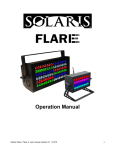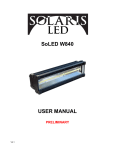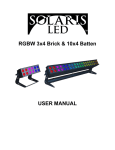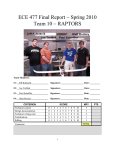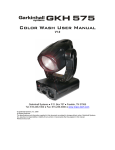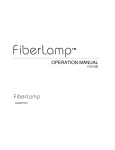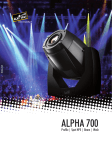Download TABLE OF CONTENTS
Transcript
USER MANUAL Flare software version 8.2 PRELIMINARY Solaris FLARE user manual version 8.3.8 020513 PRELIMINARY 1 TABLE OF CONTENTS 1. BEFORE YOU BEGIN .................................................................................................. Product Overview What is Included Unpacking Instructions Power Requirements Frequency Setting Safety Instructions Technical Features 3 3 3 3 3 3 3 3 2. SETUP ......................................................................................................................... Fuse Replacement Fixture Linking DMX Data Cable Cable Connectors 3-Pin to 5-Pin Conversion Chart Setting up DMX Serial Data Link Fixture Mouning / Rigging 5 5 5 5 6 6 7 7 3. OPERATING INSTRUCTIONS ...................................................................................... Control Panel Navigation Menu Map Menu Function Description Basic Mode Strobe Modes Strobe-Only Mode Advanced Modes Pixel Selection Options Advanced RGB Strobe DMX Advacned RBGW Strobe DMX Manual Function 8 8 9 10 12 13 14 15 17 18 19 20 4. APPENDIX .................................................................................................................. Basics of DMX Control Limited Warranty General Maintenance Returns for Service Contact Information Technical Specifications 22 22 22 23 23 23 24 Important: Read this manual before powering or installing the unit. Follow the safety precautions listed herein. Observe all warnings in this manual and those printed on the unit. Solaris FLARE user manual version 8.3.8 020513 PRELIMINARY 2 1. BEFORE YOU BEGIN PRODUCT OVERVIEW Solaris LED FLARE is an RGBW combination wash/strobe with 1000 Watts of unprecedented RGBW LED brightness. The FLARE functions simultaneously as a brilliantly bright Wash and Strobe. One Solaris FLARE does the job of many conventional LED fixtures, saving setup time and labor. Its multiple LEDs are so powerful and closely coupled they look like a single giant LED. The sheer power of the FLARE rivals traditional tungsten DWE stage lamps but without the “dots”. Mix or bump thousands of colors instantly! Use alone or synchronize multiple units to create large-scale colorchanging strobe effects. The extremely high refresh rate of these versatile, compact RGBW fixtures make them ideal for TV and film applications, as well as theatre, concert, dance club, and rental applications of all kinds. Simultaneous color Wash and Strobe in one fixture! 1000 Watt brightness in a single LED Wash/Strobe Produces powerful “organic” light, like one giant LED Instantaneous RGBW color mixing 2200Hz refresh rate with over 2,000,000 instantaneous color changes! Pixel-map feature – 12 discrete individually-controlled LED “zones” WHAT IS INCLUDED 1 x Solaris LED FLARE 1 x Power cable User Manual UNPACKING INSTRUCTIONS Upon receiptof the fixture, carefully unpack the carton and check the contents (see above) to ensure that all parts are present and in good condition. Notify the shipper immediately and retain packing material for inspection if any parts appear damaged from shipping or the carton itself shows signs of mishandling. Save the carton and all packing materials. In the event that a fixture must be returned to the factory, it is important that the fixture be returned in the original factory box and packing. POWER REQUIREMENTS Before powering the unit, make sure the line voltage is within the range of accepted voltages. This fixture accommodates 100-240VAC, 50/60Hz. All fixtures must be powered directly from a switched circuit and cannot be operated with a rheostat (variable resistor) or dimmer circuit, even if the rheostat or dimmer channel is used solely for a 0-100% switch. When powered up, FLARE performs a pre-programmed internal test. On initial power-up the factory default DMX address appears on the display screen and FLARE is ready for operation. After initial power-up, the lastsaved DMX address last saved will appear. FREQUENCY SETTING Depending on location, change the Default Frequency setting to match the mains power (e.g. Canada and the US should be set at 60Hz). Proper frequency setting will ensure minimum amount of visible artifacts when using FLARE on camera. Solaris FLARE user manual version 8.3.8 020513 PRELIMINARY 3 SAFETY INSTRUCTIONS Please read these instructions carefully, which includes important information about the installation, usage and maintenance of this product. ● ● ● ● ● ● ● ● ● ● ● Please keep this User Guide for future reference. If you sell the unit to another user, be sure that they also receive this instruction booklet. Always make sure that you are connecting to the proper voltage, and that the line voltage you are connecting to is not higher than that stated on the decal or rear panel of the fixture. Make sure there are no flammable materials close to the unit while operating. Always disconnect from the power source before servicing or replacing fuses and be sure to replace with same fuse type Secure the fixture to what you have attached it to using a safety chain. Maximum ambient temperature (Ta) is (40°C). Do not operate fixture at temperatures higher than this. In the event of a serious operating problem, stop using the unit immediately. Never try to repair the unit by yourself. Repairs carried out by an unskilled person can lead to damage or malfunction. Please contact the nearest authorized technical assistance center. Always use the same type of spare parts. Do not connect the device to a dimmer pack. Make sure the power cord is never crimped or damaged. Never disconnect the power cord by pulling or tugging on the cord. Avoid direct eye exposure to the light source while it is on. Caution! There are no user serviceable parts inside the unit. Do not open the housing or attempt any repairs yourself. In the unlikely event your unit may require service, please contact your distributor. Technical Features / Description 96 units of RGBW LEDs (10W each), divided in to 1, 2, 3, 4, 6 or 12 pixels Variable intensity control 0-100% in 8bit or 16bit control modes Beam spread: 36° Refresh reate: 1200HZ Flash Duration control 0-650ms flashes per second Flash Rate control 0-16.7 Hz (50 Hz) / 0-20 Hz (60 Hz) Continuous blinder/wash effect Flash intensity curve selection User definable fades LCD control panel display with 4 control buttons Solaris FLARE user manual version 8.3.8 020513 PRELIMINARY 4 2. SETUP Disconnect the power cord before replacing a fuse and always replace with the same type fuse. FUSE REPLACEMENT The FLARE uses a 12A 250V slow-blow fuse (5x20mm). To replace fuse: 1. With a screwdriver turn the fuse cap counter-clockwise to remove fuse cap with fuse. 2. Replace fuse attached to fuse cap. 3. Reinsert fuse cap with new fuse and tighten clockwise. FIXTURE LINKING A DMX data link is needed to operate one or more fixtures via a DMX-512 lighting console. The combined number of channels required by all the fixtures on a DMX data link determines the number of fixtures the DMX data link can support. Important: Fixtures on a DMX data link must be daisy-chained in one single line. To comply with the EIA485 standard, no more than 32 devices should be connected on one data link. Connecting more than 32 fixtures on one serial data link without the use of a DMX optically-isolated splitter may result in deterioration of the digital DMX signal. Maximum recommended DMX data link distance between fixtures: 984 ft. (300 meters). DMX DATA CABLE Use a ProPlex® DMX cable or equivalent which meets the specifications for EIA RS-485 applications. Standard microphone cables cannot transmit DMX data reliably over long distances. The data cable must have the following characteristics: 2-conductor twisted pair plus a shield Max. capacitance between conductors – 30 pF/ft. Max. capacitance between conductor and shield – 55 pF/ft. Max. resistance of 20 ohms / 1000 ft. Nominal impedance 100-140 ohms Solaris FLARE user manual version 8.3.8 020513 PRELIMINARY 5 CABLE CONNECTORS Cabling must have a male XLR connector on one end and a female XLR connector on the other end. DMX connector configuration CAUTION: Do not allow contact between the common and the fixture’s chassis ground. Grounding the common can cause a ground loop, and your fixture may perform erratically. Test cables with an ohm meter to verify correct polarity and to make sure the pins are not grounded or shorted to the shield or each other. 3-PIN TO 5-PIN CONVERSION CHART If you use a console with a 3-pin DMX output connector, use a 3-pin to 5-pin adapter. The chart below details a proper conversion: 3-Pin Male (Input) 5-Pin Male (Output) Purpose Pin 1 Pin 1 Ground / Shield Pin 2 Pin 2 Data ( - ) signal Pin 3 Pin 3 Data ( + ) signal Pin 4 Not Used Pin 5 Not Used Solaris FLARE user manual version 8.3.8 020513 PRELIMINARY 6 SETTING UP A DMX SERIAL DATA LINK 1) Connect the male 5-pin XLR connector of the data cable to the female 5-pin XLR output of the DMX console. Connect the other end of the data cable (female 5-pin XLR) to the male 5-pin XLR connector located on the Solaris FLARE. 2) Connect from the fixture output as stated above to the input of the following fixture, and so forth. 3) Continue linking until the last fixture is conected in your DMX signal data chain. FIXTURE MOUNTING Orientation FLARE fixtures may be mounted in any position. Always make sure there is adequate room for ventilation. Do not obstruct unit’s fan or vents. Support Stand Always use a professional stand rated to support weight greater than the Solaris FLARE weight (14.3 lb / 6.5 kg). Attach a TVMP spigot to the yoke of the Solaris FLARE and mount on the stand. Rigging ® Use a ProBurger coupler or equivalent C- or O-type clamp for attaching to truss. It is important never to obstruct the fan or vents pathway. Adjust the angle of the fixture by loosening both knobs and tilting the fixture. After finding the desired position, retighten both knobs. When selecting installation location, consider lamp replacement access and routine maintenance. Safety cables must always be used. Never mount fixture where it will be exposed to moisture, high humidity, extreme temperatures, or restricted ventilation. Solaris FLARE user manual version 8.3.8 020513 PRELIMINARY 7 3. OPERATING INSTRUCTIONS CONTROL PANEL NAVIGATION Access control panel functions using the four control panel buttons located directly underneath the LCD Display. The Control Panel LCD Display shows the menu items selected from the menu map (see page 9). When a menu function is selected, the display will show the first available option for the selected menu function. To select a menu item, press <MENU>. Press and hold the <MENU> button to scroll through the top level menu items. This is the top of the menu map. Use the <UP> and <DOWN> buttons, located right from LCD screen, to navigate the menu map and menu options. Press the <MENU> button to access the menu function currently displayed or to enable a menu option. To return to the top of the menu map or menu without changing the value, press the < X > button. Main Menu Functions: DMX Address – DMX address selection Control – Control mode selection menu Manual – Manual Control Demo – Demonstration scenes Config – Configuratio Menu During normal operation, the Control Panel LED Display indicates DMX start address. When the DMX signal is not connected, or if the FLARE is not recieving a DMX signal, the address blinks RED. Solaris FLARE user manual version 8.3.8 020513 PRELIMINARY 8 MENU MAP Solaris FLARE user manual version 8.3.8 020513 PRELIMINARY 9 MENU FUNCTION DESCRIPTION DMX Address – To set the required DMX address, open the Main Menu: 1) Press and hold <MENU> button to open the Main Menu. 2) Use <up> and <down> buttons to find the DMX address function. 3) Press <Select> button to access the DMX address value change submenu. 4) Use <up> and <down> buttons to set necessary DMX address value (e.g. 198 DMX address). 5) Use <Select> button to confirm new DMX address. 6) When the new DMX address is confirmed, return to Main Menu. Press <EXIT> button to return fixture at workstate. 7) The work-state control panel display shows current DMX address, in this case it is 198. Additional info is displayed under the DMX address: selected control mode, channels used by this mode, and occupied DMX addresses (DMX footprint.) In this case MODE: RGB pix:1 (10ch) DMX footprint: 198 - 202 (meaning: RGB control mode with 1 pixel using 10 dmx channels uses DMX 198 to 202). Solaris FLARE user manual version 8.3.8 020513 PRELIMINARY 10 Control – FLARE control mode selection. The FLARE includes two fixtures (a strobe type fixture, and a wash/blinder type fixture) which can combined to suit your needs. In each of the control modes, the fixture occupies different amounts of DMX channels and has different control channels. To enter the Control submenu, follow these steps: 1) Press and hold <MENU> button to open the Main Menu. 2) Use <up> and <down> buttons to find the Control submenu. 3) Press <Select> button to access the Control submenu. 4) Choose the correct Control Mode type. Basic or Advanced.. Solaris FLARE user manual version 8.3.8 020513 PRELIMINARY 11 When the Control submenu is opened, there are two settings: Basic – This mode allows for simple control of the FLARE as a Blinder/Wash fixture, or as a Strobe. Advanced – This mode allows for independant control of the FLARE Blinder/Wash functions, and the Strobing functions This mode also allows for independant color and intensity control of every segment of LEDs independantly. BASIC MODE In Basic Mode, you have the option of using the fixture as a wash/blinder, generic strobe, or color strobe. The first modes are the RGB and RGBW modes in either 8bit resolution or 16bit resolution. The RGB modes are designed to automatically adjust the white LEDS according to the RGB mix coming from the lighting controller. The RGBW modes are designed to give independant control of all 4 colors. 8 bit control uses one DMX channel for each color, and 16 bit control allows for two DMX channels of control to give the lighting controller more steps of dimming. Mode RGB 8bit RGB 16bit Channel DMX values Precent 1 0 - 255 0 - 100 Red Intensity 2 0 - 255 0 - 100 Green Intensity 3 1 0 - 255 0 - 255 0 - 100 0 - 100 Blue Intensity Red Intensity HI Byte 2 0 - 255 0 - 100 Red Intensity LOW Byte 3 0 - 255 0 - 100 Green Intensity HI Byte 4 0 - 255 0 - 100 Green Intensity LOW Byte 5 0 - 255 0 - 100 Blue Intensity HI Byte 6 0 - 255 0 - 100 Blue Intensity LOW Byte Solaris FLARE user manual version 8.3.8 Function 020513 PRELIMINARY 12 Mode Channel DMX values Precent 1 0 - 255 0 - 100 Red Intensity 2 0 - 255 0 - 100 Green Intensity 3 0 - 255 0 - 100 Blue Intensity 4 1 2 0 - 255 0 - 255 0 - 255 0 - 100 0 - 100 0 - 100 White Intensity Red Intensity HI Byte Red Intensity LOW Byte 3 0 - 255 0 - 100 Green Intensity HI Byte 4 0 - 255 0 - 100 Green Intensity LOW Byte 5 0 - 255 0 - 100 Blue Intensity HI Byte 6 0 - 255 0 - 100 Blue Intensity LOW Byte 7 0 - 255 0 - 100 White Intensity HI Byte 8 0 - 255 0 - 100 White Intensity LOW Byte RGBW 8bit RGBW 16bit Function STROBE MODES Four channels control the functions of the strobe parameter: Strobe Intensity, Strobe Duration, Strobe Rate and Strobe FX. DMX Values Precent 0-5 6 - 255 0-1 2 - 100 Second Strobe Channel Blackout Intensity level Flash duration 0 - 255 0 - 100 Third Strobe Channel 0 - 650 ms (50Hz AC) 0 - 530 ms (60Hz AC) Flash rate 0-5 6 - 255 0-1 2 - 100 No flash 0.5 - 25 Hz (50Hz AC) 0.6 - 30 Hz (60Hz AC) Flash effects 0-4 5 0-1 2 6 - 42 43 - 85 3 - 16 17 - 33 Ramp up Ramp down 86 - 128 129 - 171 172 - 214 34 - 50 51 - 67 68 - 84 Ramp up - down Random Lighting 215 - 255 85 - 100 Spikes Channel First Strobe Channel Fourth Strobe Channel Strobe Function Flash intensity No effect DMX Wash/Blinder Overide Solaris FLARE user manual version 8.3.8 020513 PRELIMINARY 13 Mode RGB Strobe RGBW Strobe 1 DMX values 0 - 255 2 Channel Precent Function 0 - 100 Red Strobe Intensity 0 - 255 0 - 100 Green Strobe Intensity 3 0 - 255 0 - 100 Blue Strobe Intensity 4 0 - 255 0 - 100 Strobe Intensity 5 0 - 255 0 - 100 Strobe Duration 6 0 - 255 0 - 100 Strobe Rate 7 0 - 255 0 - 100 Strobe FX 1 0 - 255 0 - 100 Red Strobe Intensity 2 0 - 255 0 - 100 Green Strobe Intensity 3 0 - 255 0 - 100 Blue Strobe Intensity 4 0 - 255 0 - 100 White Strobe Intensity 5 0 - 255 0 - 100 6 0 - 255 0 - 100 Strobe Intensity Strobe Duration 7 0 - 255 0 - 100 Strobe Rate 8 0 - 255 0 - 100 Strobe FX Note: In RGB Strobe and RGBW Strobe modes, a feature in the Strobe FX channel allows the FLARE to become a temporary wash/blinder fixture. If you set the Strobe FX channel to DMX value 5, the Strobe color Channels become strobe wash/blinder color channels. For example, the FLARE can be strobing in White, and then quickly changed to a Blue Wash fixture. White strobing: Strobe Color Channels @ DMX 255, Strobing channels as desired. Blue Wash: Strobe Color channels to Blue-only @ DMX 255, Strobe FX @ DMX 5, the other strobe channels are ignored. STROBE-ONLY MODE In this mode, the fixture can act as a generic 4 channel Strobe. In this mode you can select your strobe color after selecting this mode. Solaris FLARE user manual version 8.3.8 020513 PRELIMINARY 14 Strobe Only Mode 1 0 - 255 0 - 100 Strobe Intensity 2 0 - 255 0 - 100 Strobe Duration 3 0 - 255 0 - 100 Strobe Rate 4 0 - 255 0 - 100 Strobe FX ADVANCED MODES This control submenu setup is for advanced users allowing control of both Strobe Color and Strobe Intensity/Duration/Rate/FX independantly of Wash/Blinder background color. This also allows independant control individual segments of 8 LEDs in the array. You have the choice of either RGB or RGBW control over the color, and how many segments you wish to divide the fixture into. The LED segments are comprised of 8 LEDs. There are two sgements of 8 LEDs per row. There are 6 rows of LEDs, for a total of 12 controllable segments. The more segments chosen, the more sets of RGB or RGBW follow the Strobe Color and Strobe Control channels. Choose how many sections (PIXELS) of control after choosing color mode (RGB or RGBW). Solaris FLARE user manual version 8.3.8 020513 PRELIMINARY 15 Solaris FLARE user manual version 8.3.8 020513 PRELIMINARY 16 PIXEL SELECTION OPTIONS There are 8 options for subdividing the fixture. Some applications may require less subdivisions than others, allowing allows the operator to patch the least amount of channels for the application 1 2V 2H 3 1 1 1 1 1 1 1 1 1 2 2 2 1 1 3 4 1 1 3 4 1 1 3 4 1 1 1 1 2 2 2 2 1 1 3 3 2 2 4 4 1 1 2 2 5 5 6 6 1 1 1 1 1 1 3 2 2 4 2 2 2 2 5 6 1 1 1 2 4 6V 1 2 6H 12 1 2 1 2 3 5 4 6 2 2 7 8 3 3 9 10 3 3 11 12 Note: Only the entire fixture can be Strobed. Operators can chase individual sections with intensity or color very quickly to simulate strobing of individual segments, however, Strobe functions and Strobe color can only be set for the whole fixture. Solaris FLARE user manual version 8.3.8 020513 PRELIMINARY 17 ADVANCED RGB STROBE DMX CHANNELS PIXEL MODE RGB PIXEL MODE 1 RGB PIXEL MODE 2 RGB PIXEL MODE 3 RGB PIXEL MODE 4 RGB PIXEL MODE 6H or 6V RGB PIXEL MODE 12 CHANNEL DMX VALUE PERCENT 1 0 - 255 0 - 100 Red Strobe Intensity 2 0 - 255 0 - 100 Green Strobe Intensity 3 0 - 255 0 - 100 Blue Strobe Intensity 4 0 - 255 0 - 100 Strobe Intensity 5 0 - 255 0 - 100 Strobe Duration 6 0 - 255 0 - 100 Strobe Rate 7 0 - 255 0 - 100 Strobe FX 8 0 - 255 0 - 100 1 pix Red intensity 9 0 - 255 0 - 100 1 pix Green intensity 10 0 - 255 0 - 100 1 pix Blue intensity 11 0 - 255 0 - 100 2 pix Red intensity 12 0 - 255 0 - 100 2 pix Green intensity 13 0 - 255 0 - 100 2 pix Blue intensity 14 0 - 255 0 - 100 3 pix Red intensity 15 0 - 255 0 - 100 3 pix Green intensity 16 0 - 255 0 - 100 3 pix Blue intensity 17 0 - 255 0 - 100 4 pix Red intensity 18 0 - 255 0 - 100 4 pix Green intensity 19 0 - 255 0 - 100 4 pix Blue intensity 20 0 - 255 0 - 100 5 pix Red intensity 21 0 - 255 0 - 100 5 pix Green intensity 22 0 - 255 0 - 100 5 pix Blue intensity 23 0 - 255 0 - 100 6 pix Red intensity 24 0 - 255 0 - 100 6 pix Green intensity 25 0 - 255 0 - 100 6 pix Blue intensity 26 0 - 255 0 - 100 7 pix Red intensity 27 0 - 255 0 - 100 7 pix Green intensity 28 0 - 255 0 - 100 7 pix Blue intensity 29 0 - 255 0 - 100 8 pix Red intensity 30 0 - 255 0 - 100 8 pix Green intensity 31 0 - 255 0 - 100 8 pix Blue intensity 32 0 - 255 0 - 100 9 pix Red intensity 33 0 - 255 0 - 100 9 pix Green intensity 34 0 - 255 0 - 100 9 pix Blue intensity 35 0 - 255 0 - 100 10 pix Red intensity 36 0 - 255 0 - 100 10 pix Green intensity 37 0 - 255 0 - 100 10 pix Blue intensity 38 0 - 255 0 - 100 11 pix Red intensity 39 0 - 255 0 - 100 11 pix Green intensity 40 0 - 255 0 - 100 11 pix Blue intensity 41 0 - 255 0 - 100 12 pix Red intensity 42 0 - 255 0 - 100 12 pix Green intensity 43 0 - 255 0 - 100 12 pix Blue intensity Solaris FLARE user manual version 8.3.8 FUNCTION 020513 PRELIMINARY 18 ADVANCED RGBW STROBE DMX CHANNELS PIXEL MODE RGBW PIXEL MODE 1 RGBW PIXEL MODE 2V or 2H RGBW PIXEL MODE 3 RGBW PIXEL MODE 4 RGBW PIXEL MODE 6H or 6V RGBW PIXEL MODE 12 CHANNEL DMX VALUE PERCENT 1 0 - 255 0 - 100 Red Strobe Intensity 2 0 - 255 0 - 100 Green Strobe Intensity 3 0 - 255 0 - 100 Blue Strobe Intensity 4 0 - 255 0 - 100 White Strobe Intensity 5 0 - 255 0 - 100 Strobe Intensity 6 0 - 255 0 - 100 Strobe Duration 7 0 - 255 0 - 100 Strobe Rate 8 0 - 255 0 - 100 Strobe FX 9 0 - 255 0 - 100 1 pix Red intensity 10 0 - 255 0 - 100 1 pix Green intensity 11 0 - 255 0 - 100 1 pix Blue intensity 12 0 - 255 0 - 100 1 pix White intensity 13 0 - 255 0 - 100 2 pix Red intensity 14 0 - 255 0 - 100 2 pix Green intensity 15 0 - 255 0 - 100 2 pix Blue intensity 16 0 - 255 0 - 100 2 pix White intensity 17 0 - 255 0 - 100 3 pix Red intensity 18 0 - 255 0 - 100 3 pix Green intensity 19 0 - 255 0 - 100 3 pix Blue intensity 20 0 - 255 0 - 100 3 pix White intensity 21 0 - 255 0 - 100 4 pix Red intensity 22 0 - 255 0 - 100 4 pix Green intensity 23 0 - 255 0 - 100 4 pix Blue intensity 24 0 - 255 0 - 100 4 pix White intensity 25 0 - 255 0 - 100 5 pix Red intensity 26 0 - 255 0 - 100 5 pix Green intensity 27 0 - 255 0 - 100 5 pix Blue intensity 28 0 - 255 0 - 100 5 pix White intensity 29 0 - 255 0 - 100 6 pix Red intensity 30 0 - 255 0 - 100 6 pix Green intensity 31 0 - 255 0 - 100 6 pix Blue intensity 32 0 - 255 0 - 100 6 pix White intensity 33 0 - 255 0 - 100 7 pix Red intensity 34 0 - 255 0 - 100 7 pix Green intensity 35 0 - 255 0 - 100 7 pix Blue intensity 36 0 - 255 0 - 100 7 pix White intensity 37 0 - 255 0 - 100 8 pix Red intensity 38 0 - 255 0 - 100 8 pix Green intensity 39 0 - 255 0 - 100 8 pix Blue intensity 40 0 - 255 0 - 100 8 pix White intensity 41 0 - 255 0 - 100 9 pix Red intensity 42 0 - 255 0 - 100 9 pix Green intensity 43 0 - 255 0 - 100 9 pix Blue intensity 44 0 - 255 0 - 100 9 pix White intensity 45 0 - 255 0 - 100 10 pix Red intensity Solaris FLARE user manual version 8.3.8 020513 PRELIMINARY FUNCTION 19 46 0 - 255 0 - 100 10 pix Green intensity 47 0 - 255 0 - 100 10 pix Blue intensity 48 0 - 255 0 - 100 10 pix White intensity 49 0 - 255 0 - 100 11 pix Red intensity 50 0 - 255 0 - 100 11 pix Green intensity 51 0 - 255 0 - 100 11 pix Blue intensity 52 0 - 255 0 - 100 11 pix White intensity 53 0 - 255 0 - 100 12 pix Red intensity 54 0 - 255 0 - 100 12 pix Green intensity 55 0 - 255 0 - 100 12 pix Blue intensity 56 0 - 255 0 - 100 12 pix White intensity MANUAL FUNCTION This menu function allows selection of the intensity of wash/blinder background color, strobe color, and strobe functions. This functions as a stand-alone mode. Manual values are saved if power is shut down. A reset will clear these values (see Menu Map, page 9). Demo – In this menu the folowing demonstraton scenes may be selected: Demo 1 - Red color test Demo 2 - Green color test Demo 3 - Blue color test Demo 4 - White color test Demo 5 - Yellow color test Demo 6 - Cyan color test Demo 7 - Magenta color test Demo 8 - White (RGB) color test Demo 9 - Color Amplitude Modulation, blure edge transition test Demo 10 - Color Amplitude Modulation, hard edge transition test Demo 11 - Color + Intensity Amplitude Modulation test Demo 12 - Color Intensity Amplitude Modulation test with hard edges Demo 13 - White Intensity Amplitude Modulation test Demo 14 - Red color strobe test Demo 15 - Green color strobe test Demo 16 - Blue color strobe test Demo 17 - White flash delay test Demo 18 - Red flash delay test Demo 19 - Green flash delay test Demo 20 - Blue flash delay test Demo 21 – White Fast Flash Auto 1 - Automatic selection of all demonstrations (Demo 1 – Demo 21) During the demo functions, using the <UP> and <DOWN> buttons will change the demo scenes. To exit Demo mode, press the < X > button. This mode works as a stand-alone mode, even if the FLARE is turned off and then back on, the selected demo scene will be saved. While in the Demo menu, the demonstration scene will play. When you exit from Demo mode, the FLAR will return to a normal state of operation. Config – Configuration setup. In this menu, the folowing functons may be selected: DMX LOSS – Select desired function should the FLARE lose DMX signal: HOLD – Hold the last received DMX values when DMX signal is lost OFF – Do not hold the last received DMX values when DMX signal is lost, stop light output. Fan – Cooling Fan: AUTO – Fan speed is automatically controlled by the FLARE and will adjust according to temperatures at normal operating levels. ON – Fan cooling always is turned on. Solaris FLARE user manual version 8.3.8 020513 PRELIMINARY 20 Display – Automatic power on/off: ON – Control display is turned on. 10s – Control display is turned off after 10 seconds of inactivity. 30s – Control display is turned off after 30 seconds of inactivity.. Thermometer – Internal temperature gauge: The built-in thermometer tracks internal operating temperature. Pressing the <UP> and <DOWN> buttons selects degrees Celsius to degrees Fahrenheit. Fade Time – Fade time setup. In this setup the operator can set the way the FLARE reacts to changing DMX values. This is designed to allow the light output of the FLARE to react as smoothly as possible when crossfading DMX values. OFF – The FLARE will not change the smoothness of crossfading of values coming from the lighting controller Smart Fade – The FLARE will attempt to add smoothness to crossfading DMX values coming from the lighting controller, but will also allow for very quick change of values where smoothness is not applicable. Fixed Fade – The fade time for any change in DMX values can be set manually. The timing values can be set from 0.01 to 2.50 seconds. Use the <UP> and <DOWN> buttons to change these values. Gamma – Gamma correction curve selection. This sets direct relation between AC current to the LEDs and the DMX value. The lower the value, the dimming curve and steps of intensity will be more noticeable at the bottom of the DMX range. The higher the value, the smoother the bottom end of the curve will be where the human eye detects more subtle changes. Gamma 8 – 8-bit rate Gamma correction setup. Color dimming curve values can be set from 1.0 to 5.0. The default value is 3.0 Gamma 16 – 16-bit rate Gamma correction setup. Each color dimming curve values from 1.0 to 5.0. The default value is 1.0 Upload – Upload software. Designed to cross-load software from one FLARE to others in the DMX data chain. This should not be used when other fixture types are in the data chain. Use of this function will be prompted by Password. The password is 111. Line Freq – Line Frequency. Allows adjustment of FLARE input power frequency to match local source power for minimum visual artifacts on camera. The setting depends on region of use and power source. There are two options: 50Hz and 60Hz. Use the <UP> and <DOWN> buttons to change these values. Reset – Set factory defaults. Two options: NO and YES. Use the <UP> and <DOWN> buttons to change these values. Solaris FLARE user manual version 8.3.8 020513 PRELIMINARY 21 4. APPENDIX BASICS OF DMX CONTROL There are 512 channels in a DMX-512 connection. Channels may be assigned in any manner. A fixture capable of receiving DMX-512 will require one or a number of sequential channels. The user must assign a starting address on the fixture that indicates the first channel reserved in the lighting console. There are many different types of DMX controllable fixtures and they all may vary in the total number of channels required. Choosing a start address should be planned in advance. Channels should never overlap. If they do, this will result in erratic operation of the fixtures whose starting addresses are set incorrectly. You can however, control multiple fixtures of the same type using the same starting address as long as the intended result is that of unison movement or operation. In other words, the fixtures will be slaved together and all will respond in the same way. DMX fixtures are often designed to receive and transmit data through a DMX daisy-chain. A DMX daisy-chain is where the DMX OUT of one fixture connects to the DMX IN of the next fixture. The order in which the fixtures are connected is not important and has no effect on how a lighting console communicates to each fixture. Use an order that provides for the easiest and most direct cabling. Connect fixtures using shielded two conductor twisted pair cable with 5-pin XLR male to female connectors. The shield/ground is pin 1, while pin 2 is Data Negative (D-) and pin 3 is Data positive (D+). Pins 4 and 5 are not used according to the DMX-512 standard. LIMITED WARRANTY ProPlex Data Distribution Devices are warranted against defective materials or workmanship for a period of 12 months from the date of shipment. Parts and components that are not the product of the Seller (TMB) shall be subject only to the terms of any warranty that may be extended by the original manufacturer. Seller’s warranty shall be restricted to the repair or replacement of any part that proved to be defective and for which a claim is submitted to the Seller before the expiration of the applicable warranty periods. This warranty shall not apply to any defect arising from accident, misuse or improper or unauthorized adjustment or repair. No warranty is given with respect to color media or lamps, or with respect to normal wear and tear. Any claim for defective merchandise, imperfect manufacture, shortage in count, or for any other defect known by the Customer to be existing at time of delivery is waived by the Customer unless made in writing within 30 days after delivery. All warranty parts will be charged to the customer until faulty parts (or product) are returned to TMB for valuation. These parts must be returned within 30 days of receipt or warranty is void and parts/shipping become billable items. Seller will not assume any responsibility for any labor expended or materials used to replace and/or repair any equipment without Seller’s prior written authorization. Any labor charges for repairing or replacing equipment in the field will be negotiated only between the Seller and general contractor. Freight terms on warranty repairs are FOB Seller’s warehouse or factory. If warranty parts and/or repairs are required, Seller agrees to pay destination ground freight charges on the aforementioned items leaving the Seller’s facility. GENERAL MAINTENANCE To maintain optimum performance and minimize wear fixtures should be cleaned frequently. Usage and environment are contributing factors in determining frequency. As a general rule, fixtures should be cleaned at least twice a month. Dust build up reduces light output performance and can cause overheating. This can lead Solaris FLARE user manual version 8.3.8 020513 PRELIMINARY 22 to reduced lamp life and increased mechanical wear. Be sure to power off fixture before conducting maintenance. Unplug fixture from power. Use a vacuum or air compressor and a soft brush to remove dust collected on external vents and internal components. Clean all glass when the fixture is cold with a mild solution of glass cleaner or Isopropyl Alcohol and a soft lint free cotton cloth or lens tissue. Apply solution to the cloth or tissue and drag dirt and grime to the outside of the lens. Gently polish optical surfaces until they are free of haze and lint. The cleaning of internal and external optical lenses and/or mirrors must be carried out periodically to optimize light output. Cleaning frequency depends on the environment in which the fixture operates: damp, smoky or particularly dirty surrounding can cause greater accumulation of dirt on the unit’s optics. Clean with soft cloth using normal glass cleaning fluid. Always dry the parts carefully. Clean the external optics at least every 20 days. Clean the internal optics at least every 30 / 60 days. RETURN PROCEDURE Returned merchandise must be sent prepaid and in the original packing, call tags will not be issued. Package must be clearly labeled with a Return Merchandise Authorization Number (RMA #). Products returned without an RMA # will be refused. Please contact TMB and request RMA # prior to shipping the fixture. Be prepared to provide the model number, serial number and a brief description of the cause for the return. Be sure to properly pack fixture, any shipping damage resulting from inadequate packaging is the customer’s responsibility. TMB reserves the right to use its own discretion to repair or replace product(s). As a suggestion, proper UPS packing or double-boxing is always a safe method to use. Note: If you are given an RMA#, please include the following information on a piece of paper inside the box: 1) Your name 2) Your address 3) Your phone number 4) The RMA # 5) A brief description of the symptoms CONTACT INFORMATION GENERAL INFORMATION TMB US Phone: Fax: UK Phone: Fax: e-mail: web: +1 818.899.8818 +1 818.899.8813 +44 (0)20.8574.9700 +44 (0)20.8574.9701 tmb-info@tmb.com www.tmb.com 24/7 TECHNICAL SUPPORT TMB US/Canada: Toll-free UK: International: e-mail: 1 877.TMB.DUDE (+1 877.862.3833) 0800.652.5418 +1 818.794.1286 techsupport@tmb.com Solaris FLARE user manual version 8.3.8 020513 PRELIMINARY 23 TECHNICAL SPECIFICATIONS WEIGHT / DIMENSIONS Length .................................................................................................... 19.5” (497mm) Width .................................................................................................... 8.26” (210mm) Height ...................................................................................................... 9.1” (232mm) Weight .................................................................................................... 14.3 lb (6.5 kg) POWER Operating Voltage ......................................................................... 100-240VAC 50/60Hz Fuse.................................................................................12A 250V slow-blow (5x20mm) Power Consumption ............................................................................................ 1000W LIGHT SOURCE LED's............................ 96 units Cree MC-E LED's (10W ea.) divided into 12 segments Color .................................................................................................................... RGBW Beam spread ............................................................................................................. 36° THERMAL Max. ambient temperature.......................................................................+104°F (+40°C) Min. ambient temperature........................ ...................................................-77°F (-25°C) Cooling ............................................... ................................................... air cooled – fan CONTROL / PROGRAMMING DMX input ....................................................................... locking 5-pin XLR male socket DMX output .................................................................. locking 5-pin XLR female socket DMX pin config. .............................. pin 1 shield, pin 2 (-), pin 3 (+), pin 4 n/a, pin 5 n/a Control .........................................................................DMX-512 , Demo, Manual mode DMX Channels – Basic Mode............................................................................3,4,6,7,8 DMX Channels - Blind Mode...................................... 10,12,13,16,19,20,24,25,32,43,56 Power Connector ......................................................................... Input: powerCON 20A Solaris FLARE user manual version 8.3.8 020513 PRELIMINARY 24
























